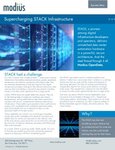As we harness AI, science, and technology to bring more progress to everyone in the world, we will need more computational power from our data centers to deliver on these ambitious goals.
This requires energy for both the production and operational lifecycle of the equipment and this presents a massive challenge to CIOs and IT leaders. How do you make sure your data center is ready to handle this new influx of data and performance requirements while meeting ambitious energy efficiency goals?
Most companies have made public commitments to decarbonize their operations and 90 percent of CEOs now say sustainability is important to their companies’ success. However, data centers are already a major consumer of electricity worldwide. According to a study by 451 Research, data centers represent more than six percent of total energy used in the US as of 2019. In Europe, by 2025, data center energy use is forecast to be 21 percent above 2018 levels.
With power grids and data center square footage frequently reaching capacity, compute density, energy efficiency, and performance optimization become the core tenets of the modern data center as IT leaders develop their AI deployment strategies.
As the world looks to sort the energy efficiency of data centers and develop the IT platforms of tomorrow, modernization and consolidation provide an opportunity for delivering exponential gains in performance and energy efficiency.
Modernization
By modernizing with the latest CPU and GPU technologies, IT leaders can optimize data center power, space, and buildout costs. The savings from these efforts can be retargeted to increase hardware footprint for more scale, or towards newer applications such as generative AI.
Data center consolidation and modernization initiatives have emerged as a powerful way for IT leaders to “make room” for new technology initiatives such as AI without breaking SLAs or budgets.
By replacing aging, inefficient servers, everyday workloads can be re-hosted onto more performant and energy-efficient infrastructure, consuming less real estate and power and leaving more of each for new innovations. The fact of the matter is, performance of older equipment generally declines over time, while the time, cost, and space needed to keep it running rises.
Older equipment is typically less able to keep pace with changing and intensifying business demands. Therefore, modernization efforts are important not just for cost savings and performance improvements, but to ensure an enterprise is ready for the future.
Efficiency
The workloads behind the services, apps, and devices that impact every aspect of our daily lives can be fairly resource-intensive. From AI in your PC to large-scale mathematically intensive computations that power algorithmic financial trading, these workloads are pervasive throughout our lives and can be taxing on outdated data centers.
One way to make a data center more energy efficient is simply to reduce its physical footprint as the latest processors are orders of magnitude more efficient than their legacy counterparts and can deliver more performance in a smaller footprint.
The bigger picture
CIOs and IT leaders increasingly face calls to provide a high-performance foundational compute infrastructure across their businesses and handle new, more demanding, use cases while balancing space and budget constraints. Still, modernization efforts are a challenge for IT leaders especially when it comes to articulating to business and executive management.
“Leaving well enough alone” is a strategy with low near-term risk but it can leave the enterprise open to missed innovation opportunities especially as AI is quickly becoming increasingly pervasive. The right hardware platform can make all the difference for such efforts.
Modern data center infrastructure can deliver increased performance and incredible energy efficiency improvements for the business-critical enterprise workloads that enhance our daily lives. However, there is no one set journey to modernization. Choosing the right vendor to help guide you on your journey is critical; whether your objective is large-scale AI deployments across your entire fleet or simply to save money on energy costs by upgrading aging infrastructure and more efficiently run your day-to-day operations.
Start by measuring your “care abouts” and work with the right vendors that will understand your workloads and guide you on your way to a modern, efficient, and performant enterprise infrastructure.




